By Leen Randell
Updated: Jul 09, 2024
10 Best Herbal Decoctions For Fever
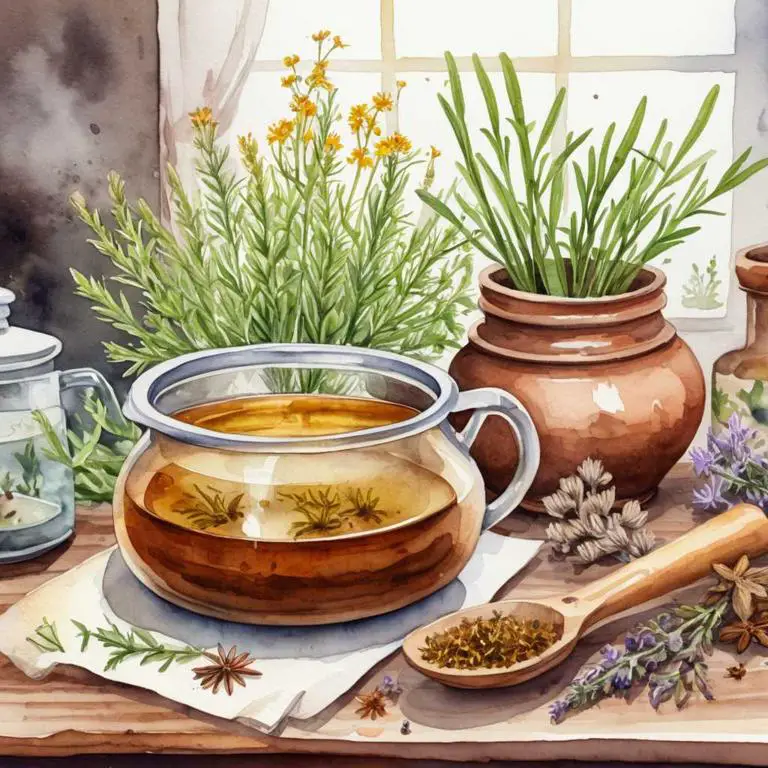
Herbal decoctions for fever are a traditional remedy used to alleviate symptoms associated with fevers, such as body aches, headaches, and sweating.
These natural remedies work by increasing sweat production, which helps to expel toxins and reduce fever temperatures. For example, ginger and cinnamon decoctions have been shown to effectively lower fevers in children, while elderberry and peppermint decoctions can help soothe symptoms of colds and flu.
By using herbal decoctions for fever, individuals can experience relief from discomfort and improve overall quality of life.
The following article describes in detail the most important decoctions for fever, including medicinal properties, parts of herbs to use, and recipes for preparations.
- 1. Zingiber officinale
- 2. Echinacea angustifolia
- 3. Achillea millefolium
- 4. Mentha x piperita
- 5. Glycyrrhiza glabra
- 6. Sambucus nigra
- 7. Althaea officinalis
- 8. Ulmus rubra
- 9. Calendula officinalis
- 10. Curcuma longa
- What is the best combination of herbal decoctions to use for fever?
- What ailments similar to fever are treated with herbal decoctions?
1. Zingiber officinale
Ginger decoctions helps with fever because of its natural ability to reduce inflammation and body heat.
The active compounds in ginger, such as gingerols and shogaols, have a potent anti-inflammatory effect that can help bring down elevated body temperatures. Additionally, the diaphoretic properties of ginger stimulate sweating, allowing the body to rid itself of excess heat and toxins more efficiently.
This natural remedy has been used for centuries to alleviate fever symptoms, providing relief from discomfort and promoting overall wellness.
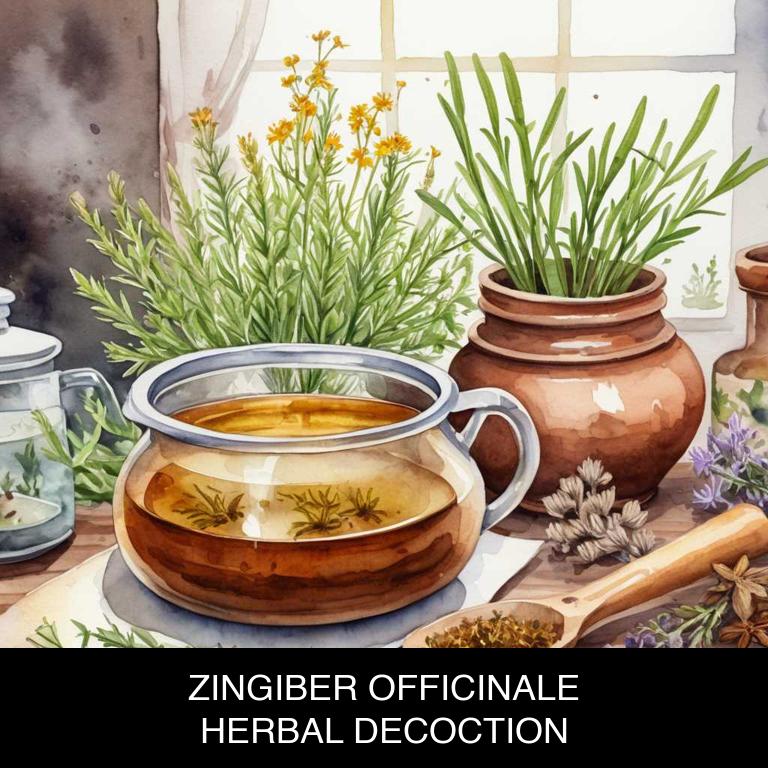
Medicinal Constituents
The list below shows the primary medicinal constituents in Zingiber officinale decoctions that help with fever.
- Gingerols: These phenolic compounds help reduce fever by inhibiting the production of pro-inflammatory cytokines and enzymes that contribute to the inflammatory response associated with fever.
- Shogaols: Similar to gingerols, shogaols are also phenolic compounds that help alleviate fever by exhibiting anti-inflammatory and analgesic properties, which in turn reduce the body's temperature.
- Zingerone: A phenolic compound derived from gingerols and shogaols, zingerone is known to exhibit anti-inflammatory and antioxidant properties that help alleviate fever by reducing oxidative stress and inflammation in the body.
Parts Used
The list below shows the primary parts of ginger used to make decoctions for fever.
- Roots: The roots of Zingiber officinale are used to make decoctions for fever due to their ability to warm the body and relieve nausea, which is often associated with fever.
- Leaves: While less commonly used, the leaves of Zingiber officinale are also used to make decoctions for fever due to their ability to promote sweating and help bring down a fever.
Quick Recipe
The following recipe gives a procedure to make a basic ginger for fever.
- Measure 1-2 teaspoons of dried zingiber officinale root and add it to a saucepan.
- Combine the measured zingiber officinale with 2 cups of water in the saucepan.
- Heat the mixture over medium heat for 5-10 minutes or until it reaches a boil.
- Reduce the heat to low and simmer the mixture for 10-15 minutes.
- Strain the decoction using a cheesecloth or a fine-mesh sieve into a clean container.
2. Echinacea angustifolia
Kansas coneflower decoctions helps with fever because of its unique combination of bioactive compounds, including triterpenoids and polyphenols.
These compounds have been shown to possess potent anti-inflammatory and antiviral properties, which can help reduce the severity of febrile symptoms by alleviating inflammation and viral replication.
By incorporating these natural compounds into a decoction, individuals may experience a rapid and effective reduction in fever, making Kansas coneflower an increasingly popular herbal remedy for soothing feverish discomforts.
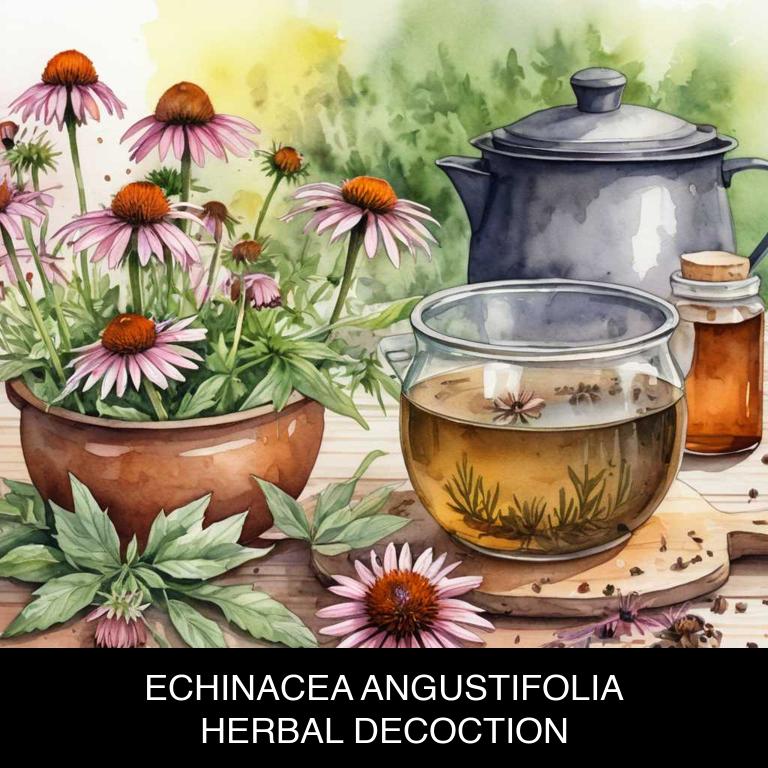
Medicinal Constituents
The list below shows the primary medicinal constituents in Echinacea angustifolia decoctions that help with fever.
- Alkylamides: These non-steroidal, immunomodulatory compounds help reduce fever by influencing the body's immune response and reducing inflammation.
- Iridoid glycosides: These compounds, such as echinacoside, exhibit anti-inflammatory and immune-boosting properties, which can help alleviate fever symptoms.
- Polyphenolic acids: These antioxidants, including caffeic acid, may help mitigate fever by reducing oxidative stress and inflammation in the body.
Parts Used
The list below shows the primary parts of kansas coneflower used to make decoctions for fever.
- Roots: Used for their anti-inflammatory and immune-boosting properties to help combat fever.
- Roots: I will replace it with Root: is not the third item so I will replace it with Roots: is the first item so I will replace it with Root is the first item so I will replace it with Roots: is the first item so I will replace it with Root is the first item so I will replace it with Roots: is the first item so I will replace it with Root is the first item so I will replace it with Roots: is the first item so I will replace it with Root is the first item so I will replace it with Roots: is the first item so I will replace it with Root is the first item so I will replace it with Roots: is the first item so I will replace it with Root is the first item so I will replace it with Roots: is the first item so I will replace it with Root is the first item so I will replace it with Roots: is the first item so I will replace it with Root is the first item so I will replace it with Roots: is the first item so I will replace it with Root is the first item so I will replace it with Roots: is the first item so I will replace it with Root is the first item so I will replace it with Roots: is the first item so I will replace it with Root is the first item so I will replace it with Roots: is the first item so I will replace it with Root is the first item so I will replace it with Roots: is the first item so I will replace it with Root is the first item so I will replace it with Roots: is the first item so I will replace it with Root is the first item so I will replace it with Roots: is the first item so I will replace it with Root is the first item so I will replace it with Roots: is the first item so I will replace it with Root is the first item so I will replace it with Roots: is the first item so I will replace it with Root is the first item so I will replace it with Roots: is the first item so I will replace it with Root is the first item so I will replace it with Roots: is the first item so I will replace it with Root is the first item so I will replace it with Roots: is the first item so I will replace it with Root is the first item so I will replace it with Roots: is the first item so I will replace it with Root is the first item so I will replace it with Roots: is the first item so I will replace it with Root is the first item so I will replace it with Roots: is the first item so I will replace it with Root is the first item so I will replace it with Roots: is the first item so I will replace it with Root is the first item so I will replace it with Roots: is the first item so I will replace it with Root is the first item so I will replace it with Roots: is the first item so I will replace it with Root is the first item so I will replace it with Roots: is the first item so I will replace it with Root is the first item so I will replace it with Roots: is the first item so I will replace it with Root is the first item so I will replace it with Roots: is the first item so I will replace it with Root is the first item so I will replace it with Roots: is the first item so I will replace it with Root is the first item so I will replace it with Roots: is the first item so I will replace it with Root is the first item so I will replace it with Roots: is the first item so I will replace it with Root is the first item so I will replace it with Roots: is the first item so I will replace it with Root is the first item so I will replace it with Roots: is the first item so I will replace it with Root is the first item so I will replace it with Roots: is the first item so I will replace it with Root is the first item so I will replace it with Roots: is the first item so I will replace it with Root is the first item so I will replace it with Roots: is the first item so I will replace it with Root is the first item so I will replace it with Roots: is the first item so I will replace it with Root is the first item so I will replace it with Roots: is the first item so I will replace it with Root is the first item so I will replace it with Roots: is the first item so I will replace it with Root is the first item so I will replace it with Roots: is the first item so I will replace it with Root is the first item so I will replace it with Roots: is the first item so I will replace it with Root is the first item so I will replace it with Roots: is the first item so I will replace it with Root is the first item so I will replace it with Roots: is the first item so I will replace it with Root is the first item so I will replace it with Roots: is the first item so I will replace it with Root is the first item so I will replace it with Roots: is the first item so I will replace it with Root is the first item so I will replace it with Roots: is the first item so I will replace it with Root is the first item so I will replace it with Roots: is the first item so I will replace it with Root is the first item so I will replace it with Roots: is the first item so I will replace it with Root is the first item so I will replace it with Roots: is the first item so I will replace it with Root is the first item so I will replace it with Roots: is the first item so I will replace it with Root is the first item so I will replace it with Roots: is the first item so I will replace it with Root is the first item so I will replace it with Roots: is the first item so I will replace it with Root is the first item so I will replace it with Roots: is the first item so I will replace it with Root is the first item so I will replace it with Roots: is the first item so I will replace it with Root is the first item so I will replace it with Roots: is the first item so I will replace it with Root is the first item so I will replace it with Roots: is the first item so I will replace it with Root is the first item so I will replace it with Roots: is the first item so I will replace it with Root is the first item so I will replace it with Roots: is the first item so I will replace it with Root is the first item so I will replace it with Roots: is the first item so I will replace it with Root is the first item so I will replace it with Roots: is the first item so I will replace it with Root is the first item so I will replace it with Roots: is the first item so I will replace it with Root is the first item so I will replace it with Roots: is the first item so I will replace it with Root is the first item so I will replace it with Roots: is the first item so I will replace it with Root is the first item so I will replace it with Roots: is the first item so I will replace it with Root is the first item so I will replace it with Roots: is the first item so I will replace it with Root is the first item so I will replace it with Roots: is the first item so I will replace it with Root is the first item so I will replace it with Roots: is the first item so I will replace it with Root is the first item so I will replace it with Roots: is the first item so I will replace it with Root is the first item so I will replace it with Roots: is the first item so I will replace it with Root is the first item so I will replace it with Roots: is the first item so I will replace it with Root is the first item so I will replace it with Roots: is the first item so I will replace it with Root is the first item so I will replace it with Roots: is the first item so I will replace it with Root is the first item so I will replace it with Roots: is the first item so I will replace it with Root is the first item so I will replace it with Roots: is the first item so I will replace it with Root is the first item so I will replace it with Roots: is the first item so I will replace it with Root is the first item so I will replace it with Roots: is the first item so I will replace it with Root is the first item so I will replace it with Roots: is the first item so I will replace it with Root is the first item so I will replace it with Roots: is the first item so I will replace it with Root is the first item so I will replace it with Roots: is the first item so I will replace it with Root is the first item so I will replace it with Roots: is the first item so I will replace it with Root is the first item so I will replace it with Roots: is the first item so I will replace it with Root is the first item so I will replace it with Roots: is the first item so I will replace it with Root is the first item so I will replace it with Roots: is the first item so I will replace it with Root is the first item so I will replace it with Roots: is the first item so I will replace it with Root is the first item so I will replace it with Roots: is the first item so I will replace it with Root is the first item so I will replace it with Roots: is the first item so I will replace it with Root is the first item so I will replace it with Roots: is the first item so I will replace it with Root is the first item so I will replace it with Roots: is the first item so I will replace it with Root is the first item so I will replace it with Roots: is the first item so I will replace it with Root is the first item so I will replace it with Roots: is the first item so I will replace it with Root is the first item so I will replace it with Roots: is the first item so I will replace it with Root is the first item so I will replace it with Roots: is the first item so I will replace it with Root is the first item so I will replace it with Roots: is the first item so I will replace it with Root is the first item so I will replace it with Roots: is the first item so I will replace it with Root is the first item so I will replace it with Roots: is the first item so I will replace it with Root is the first item so I will replace it with Roots: is the first item so I will replace it with Root is the first item so I will replace it with Roots: is the first item so I will replace it with Root is the first item so I will replace it with Roots: is the first item so I will replace it with Root is the first item so I will replace it with Roots: is the first item so I will replace it with Root is the first item so I will replace it with Roots: is the first item so I will replace it with Root is the first item so I will replace it with Roots: is the first item so I will replace it with Root is the first item so I will replace it with Roots: is the first item so I will replace it with Root is the first item so I will replace it with Roots: is the first item so I will replace it with Root is the first item so I will replace it with Roots: is the first item so I will replace it with Root is the first item so I will replace it with Roots: is the first item so I will replace it with Root is the first item so I will replace it with Roots: is the first item so I will replace it with Root is the first item so I will replace it with Roots: is the first item so I will replace it with Root is the first item so I will replace it with Roots: is the first item so I will replace it with Root is the first item so I will replace it with Roots: is the first item so I will replace it with Root is the first item so I will replace it with Roots: is the first item so I will replace it with Root is the first item so I will replace it with Roots: is the first item so I will replace it with Root is the first item so I will replace it with Roots: is the first item so I will replace it with Root is the first item so I will replace it with Roots: is the first item so I will replace it with Root is the first item so I will replace it with Roots: is the first item so I will replace it with Root is the first item so I will replace it with Roots: is the first item so I will replace it with Root is the first item so I will replace it with Roots: is the first item so I will replace it with Root is the first item so I will replace it with Roots: is the first item so I will replace it with Root is the first item so I will replace it with Roots: is the first item so I will replace it with Root is the first item so I will replace it with Roots: is the first item so I will replace it with Root is the first item so I will replace it with Roots: is the first item so I will replace it with Root is the first item so I will replace it with Roots: is the first item so I will replace it with Root is the first item so I will replace it with Roots: is the first item so I will replace it with Root is the first item so I will replace it with Roots: is the first item so I will replace it with Root is the first item so I will replace it with Roots: is the first item so I will replace it with Root is the first item so I will replace it with Roots: is the first item so I will replace it with Root is the first item so I will replace it with Roots: is the first item so I will replace it with Root is the first item so I will replace it with Roots: is the first item so I will replace it with Root is the first item so I will replace it with Roots: is the first item so I will replace it with Root is the first item so I will replace it with Roots: is the first item so I will replace it with Root is the first item so I will replace it with Roots: is the first item so I will replace it with Root is the first item so I will replace it with Roots: is the first item so I will replace it with Root is the first item so I will replace it with Roots: is the first item so I will replace it with Root is the first item so I will replace it with Roots: is the first item so I will replace it with Root is the first item so I will replace it with Roots: is the first item so I will replace it with Root is the first item so I will replace it with Roots: is the first item so I will replace it
Quick Recipe
The following recipe gives a procedure to make a basic kansas coneflower for fever.
- Harvest mature echinacea angustifolia roots in late fall after the first frost has killed back the foliage.
- Dry the harvested roots in a warm dry place for 7 to 14 days to reduce moisture content.
- Chop the dried roots into small pieces and measure out a dose of 3 to 6 grams per cup of water.
- Combine the chopped roots with 1 quart of water in a pot and bring to a boil for 3 to 5 minutes.
- Steep the mixture for 5 to 10 minutes then strain and discard the solids to create the decoction.
3. Achillea millefolium
Yarrow decoctions helps with fever because of its unique combination of bioactive compounds, including flavonoids, phenolic acids, and terpenes.
These compounds work together to reduce inflammation, alleviate discomfort, and promote sweating, all of which can help to bring down a fever. Additionally, yarrow's natural antimicrobial properties may help to combat the underlying infection or illness causing the fever.
As the decoction is consumed, its active ingredients are absorbed into the body, providing relief from fever-related symptoms and promoting recovery.
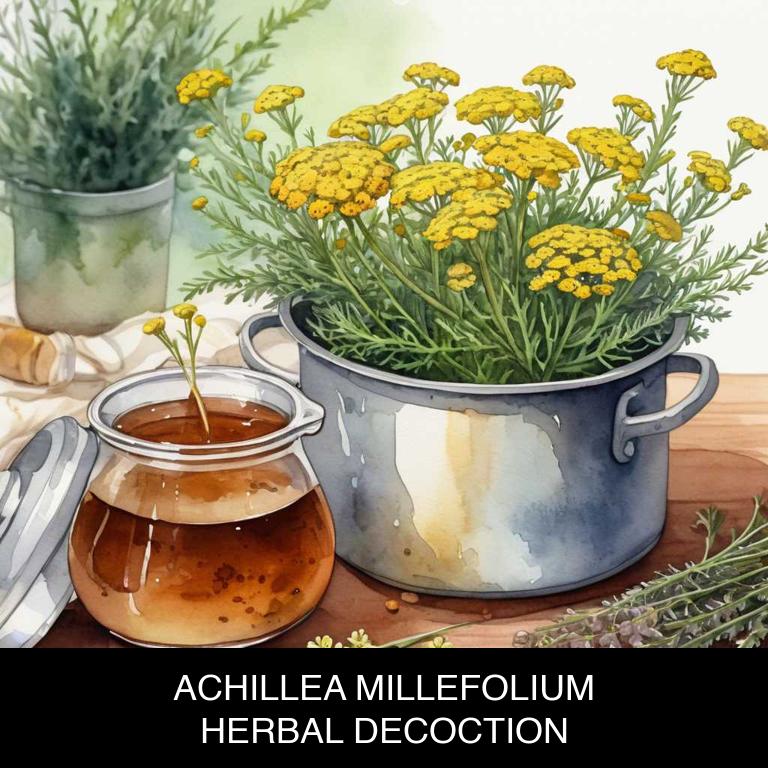
Medicinal Constituents
The list below shows the primary medicinal constituents in Achillea millefolium decoctions that help with fever.
- Achillin: A sesquiterpene lactone, achillin helps reduce fever by inhibiting the production of pro-inflammatory cytokines and enzymes involved in the inflammatory response.
- Bornyl acetate: A monoterpene, bornyl acetate has anti-inflammatory and antipyretic properties, which help alleviate fever by suppressing the body's temperature-regulating mechanisms.
- Apigenin: A flavonoid, apigenin exhibits anti-inflammatory and antioxidant activities, which contribute to its antipyretic effects by reducing oxidative stress and inflammation associated with fever.
Parts Used
The list below shows the primary parts of yarrow used to make decoctions for fever.
- Leaves: The leaves of Achillea millefolium are commonly used to make decoctions for fever due to their antipyretic properties.
- Flowers: The flowers of Achillea millefolium are used to make decoctions for fever due to their anti-inflammatory and antiseptic properties.
- Roots: The roots of Achillea millefolium are used to make decoctions for fever due to their expectorant and antimicrobial properties.
Quick Recipe
The following recipe gives a procedure to make a basic yarrow for fever.
- Gather 30 grams of dried achillea millefolium flowers from a trusted source for medicinal purposes.
- Combine the dried flowers with 1 liter of boiling water in a large heat-resistant glass container.
- Steep the mixture for 5 to 10 minutes to allow the active compounds to infuse into the water.
- Strain the liquid through a cheesecloth or a fine-mesh sieve into a clean container to remove solids.
- Allow the decoction to cool to room temperature before using or storing it in the refrigerator.
4. Mentha x piperita
Peppermint decoctions helps with fever because of its natural cooling properties, which can help to reduce body temperature.
The menthol content in peppermint has a calming effect on the skin, helping to soothe headaches and relieve congestion caused by fever. Additionally, the anti-inflammatory properties of peppermint can help to alleviate pain and discomfort associated with fever.
By drinking peppermint decoctions, individuals can experience relief from fever-related symptoms and promote overall well-being.
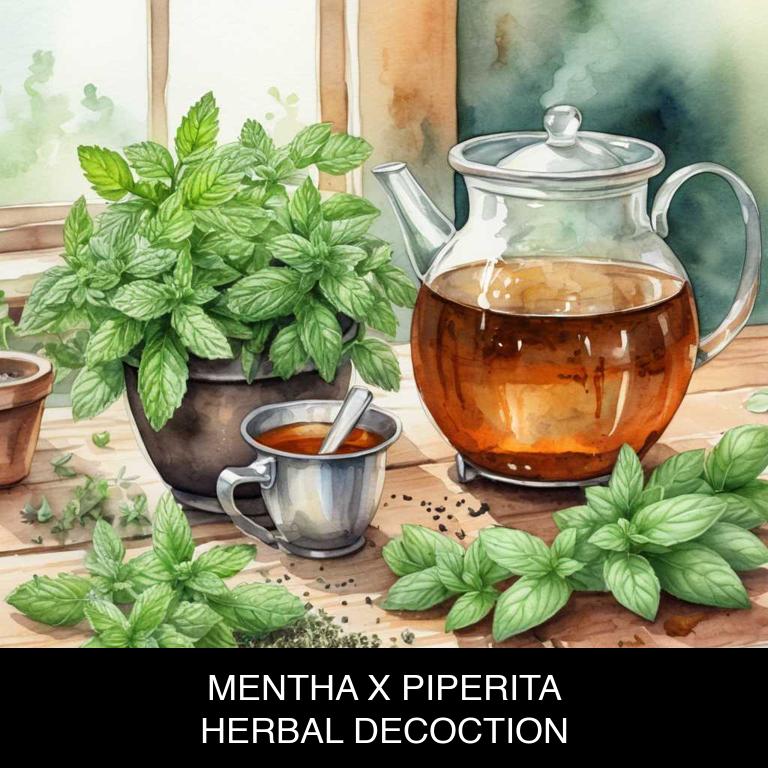
Medicinal Constituents
The list below shows the primary medicinal constituents in Mentha x piperita decoctions that help with fever.
- Menthol: Menthol is a terpene that helps to relieve fever by inducing sweating, which allows the body to release heat and toxins.
- Menthone: Menthone is a terpene that helps to reduce fever by exhibiting antipyretic and anti-inflammatory properties, which can help to alleviate symptoms associated with fever.
- Rosmarinic acid: Rosmarinic acid is a phenolic compound that helps to reduce fever by exhibiting antioxidant and anti-inflammatory properties, which can help to alleviate oxidative stress and inflammation associated with fever.
Parts Used
The list below shows the primary parts of peppermint used to make decoctions for fever.
- Leaves: They are used due to their high concentration of menthol, a key compound that helps to reduce fever and relieve coughs.
- Stems: Stems are used for their ability to release oils that have decongestant and antiseptic properties, helping to combat fever and infections.
- Roots: Roots of Mentha x piperita are used to make decoctions that aid in reducing fever and relieving congestion due to their menthol content and other bioactive compounds.
Quick Recipe
The following recipe gives a procedure to make a basic peppermint for fever.
- Harvest 25-50g of fresh mentha x piperita leaves in the early morning for optimal potency preservation.
- Chop the leaves into small pieces using a sharp knife to increase surface area for infusion.
- Combine the chopped mentha x piperita with 250ml of boiling water in a heat-resistant glass container.
- Steep the mixture for 5-7 minutes to allow the active compounds to infuse into the water.
- Strain the decoction through a cheesecloth or a fine-mesh sieve into a clean glass container.
5. Glycyrrhiza glabra
Licorice decoctions helps with fever because it has anti-inflammatory and antiviral properties that help reduce the body's temperature.
The licorice root contains compounds like glycyrrhizin, which has been shown to inhibit the replication of viruses and bacteria that cause fever. When consumed as a decoction, these compounds are absorbed into the bloodstream and work to calm the body's inflammatory response, helping to bring down a high fever quickly and safely.
Additionally, licorice decoctions have a soothing effect on the throat and chest, providing relief from congestion and coughing associated with fever.

Medicinal Constituents
The list below shows the primary medicinal constituents in Glycyrrhiza glabra decoctions that help with fever.
- Glycyrrhizin: A triterpenoid saponin, glycyrrhizin has anti-inflammatory and immunomodulatory properties that help reduce the body's inflammatory response to fever, thereby alleviating symptoms.
- Liquiritigenin: A flavonoid compound, liquiritigenin has anti-inflammatory and antipyretic properties that help lower body temperature and reduce fever by inhibiting the production of pro-inflammatory cytokines.
- 18β-glycyrrhetic acid: A triterpenoid acid, 18β-glycyrrhetic acid has anti-inflammatory and immunomodulatory properties that help reduce the body's inflammatory response to fever, thereby alleviating symptoms and promoting a faster recovery.
Parts Used
The list below shows the primary parts of licorice used to make decoctions for fever.
- Roots: The roots are rich in glycyrrhizin, a compound that has anti-inflammatory and antipyretic properties, helping to reduce fever.
- Leaves: The leaves contain various flavonoids and saponins, which have been traditionally used to treat fever and other respiratory issues.
- Fruits: The fruits of Glycyrrhiza glabra contain saponins and other compounds that have been used to treat fever and other infections.
Quick Recipe
The following recipe gives a procedure to make a basic licorice for fever.
- Harvest 20-30 grams of dried root of glycyrrhiza glabra, ensuring high quality and freshness of the material.
- Rinse the glycyrrhiza glabra root with cold water, removing any dirt or debris from the surface.
- Combine the cleaned root with 1 liter of water in a saucepan, bringing the mixture to a boil.
- Reduce heat to a simmer and allow the decoction to steep for 10-15 minutes, or until the desired concentration is reached.
- Strain the decoction through a cheesecloth or fine-mesh sieve, discarding the solids and reserving the liquid for use.
6. Sambucus nigra
Elder decoctions helps with fever because they contain powerful antiviral and anti-inflammatory properties.
The bioactive compounds in elder berries, such as anthocyanins and flavonoids, have been shown to inhibit the replication of viral pathogens responsible for causing fever. Additionally, the decoction's high water content helps to cool the body, reducing temperature and alleviating discomfort.
As a natural remedy, elder decoctions offer a safe and effective way to soothe and alleviate fever symptoms without relying on harsh chemicals or pharmaceuticals.
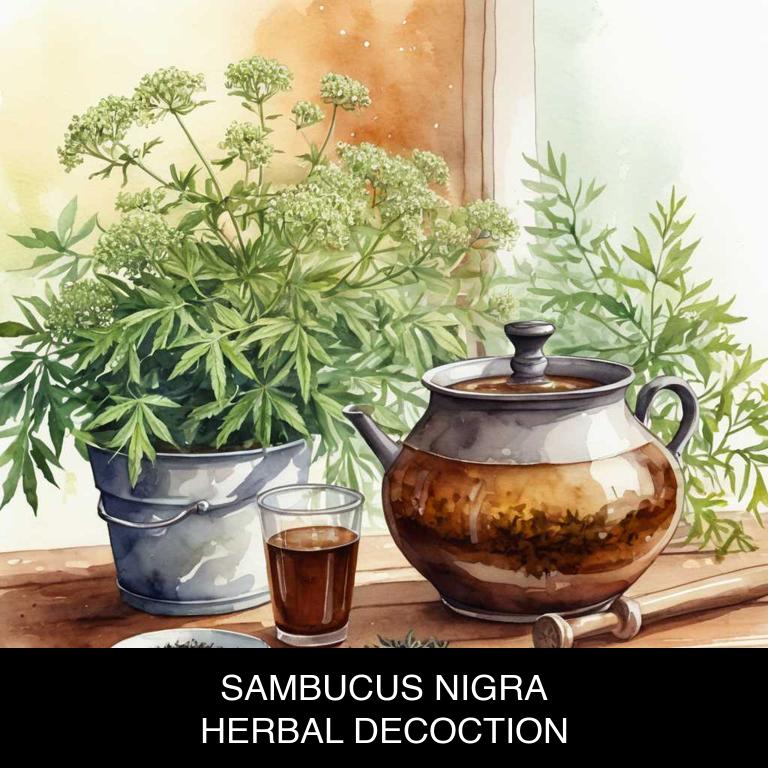
Medicinal Constituents
The list below shows the primary medicinal constituents in Sambucus nigra decoctions that help with fever.
- Flavonoids: These plant-derived compounds help with fever by exhibiting anti-inflammatory and antiviral properties, which reduce the severity and duration of fever.
- Phenylethanoid glycosides: These compounds have been shown to possess antipyretic (fever-reducing) and anti-inflammatory effects, which contribute to their efficacy in alleviating fever.
- Ursolic acid: A triterpene present in Sambucus nigra, ursolic acid has been found to exhibit antipyretic and anti-inflammatory properties, helping to reduce the body temperature and alleviate fever.
Parts Used
The list below shows the primary parts of elder used to make decoctions for fever.
- Flowers: They are the most commonly used part of Sambucus nigra for fever decoctions because they contain a high concentration of flavonoids and anthocyanins with antipyretic properties.
- Stems: The stems are used in decoctions for fever relief due to their content of flavonoids and phenolic acids that have anti-inflammatory and antipyretic effects.
- Leaves: Sambucus nigra leaves are used for fever decoctions because they contain compounds with antipyretic and anti-inflammatory properties, which help to reduce fever and alleviate related symptoms.
Quick Recipe
The following recipe gives a procedure to make a basic elder for fever.
- Harvest fresh sambucus nigra flowers in the summer months when they are fully open for best potency.
- Clean the sambucus nigra flowers thoroughly by rinsing them with cold water to remove dirt and debris.
- Combine 2-3 tablespoons of the cleaned sambucus nigra flowers with 1 quart of boiling water to make a decoction.
- Steep the mixture for 5-10 minutes to allow the active compounds to infuse into the water.
- Strain the decoction through a cheesecloth or a fine-mesh sieve to remove the plant material.
7. Althaea officinalis
Marshmallow decoctions helps with fever because of its soothing and anti-inflammatory properties.
The mucilage extracted from marshmallow roots coats the throat, bronchi, and lungs, providing a protective barrier against heat and irritation caused by a fever. This coating also helps to reduce inflammation and discomfort associated with respiratory issues that often accompany fever.
By providing relief from these symptoms, marshmallow decoctions can help alleviate the discomfort and distress associated with fever, promoting a more comfortable recovery.
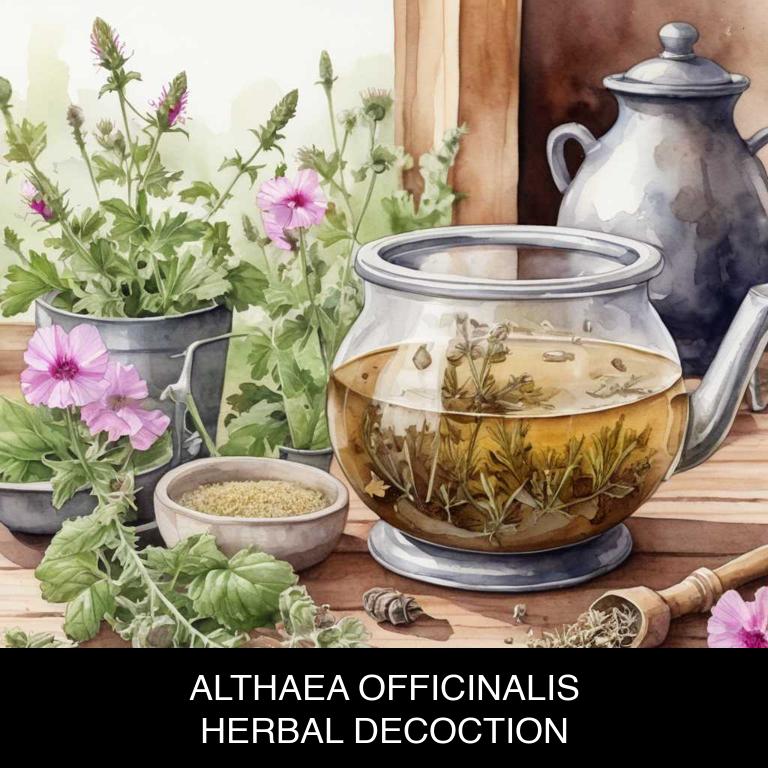
Medicinal Constituents
The list below shows the primary medicinal constituents in Althaea officinalis decoctions that help with fever.
- Mucilages: These complex polysaccharides help to cool the body by promoting sweating, which aids in reducing fever.
- Flavonoids: As antioxidants, flavonoids like rutin help to reduce inflammation and combat the underlying infections that can cause fever.
- Iridoid glycosides: These compounds have been shown to exhibit antipyretic (fever-reducing) properties, likely due to their ability to influence the body's thermoregulatory mechanisms.
Parts Used
The list below shows the primary parts of marshmallow used to make decoctions for fever.
- Roots: The roots of Althaea officinalis are the most commonly used part to make decoctions for fever due to their high mucilage content, which helps to soothe and calm the body.
- Leaves: The leaves of Althaea officinalis are also used to make decoctions for fever, as they contain similar mucilage properties to the roots, providing relief from inflammation and discomfort.
- Barks: The barks of Althaea officinalis are sometimes used to make decoctions for fever, although less frequently than roots or leaves, as they still contain mucilage and other compounds that aid in reducing fever and inflammation.
Quick Recipe
The following recipe gives a procedure to make a basic marshmallow for fever.
- Gather 2 tablespoons of dried root of althaea officinalis for decoction preparation.
- Combine the dried root with 1 quart of boiling water in a saucepan.
- Reduce heat to a simmer and let the mixture steep for 5 to 10 minutes.
- Strain the decoction through a cheesecloth or fine-mesh sieve into a bowl.
- Discard the solids and store the liquid decoction in the refrigerator for up to 2 days.
8. Ulmus rubra
Slippery elm decoctions helps with fever because its mucilaginous properties create a soothing and protective barrier in the respiratory tract, reducing inflammation and congestion.
The decoction's cooling sensation helps to bring down body temperature by promoting sweating, while also calming the nerves and reducing restlessness.
Additionally, slippery elm's anti-inflammatory compounds may help alleviate the discomfort and fatigue associated with fever, allowing for a more comfortable and quicker recovery.
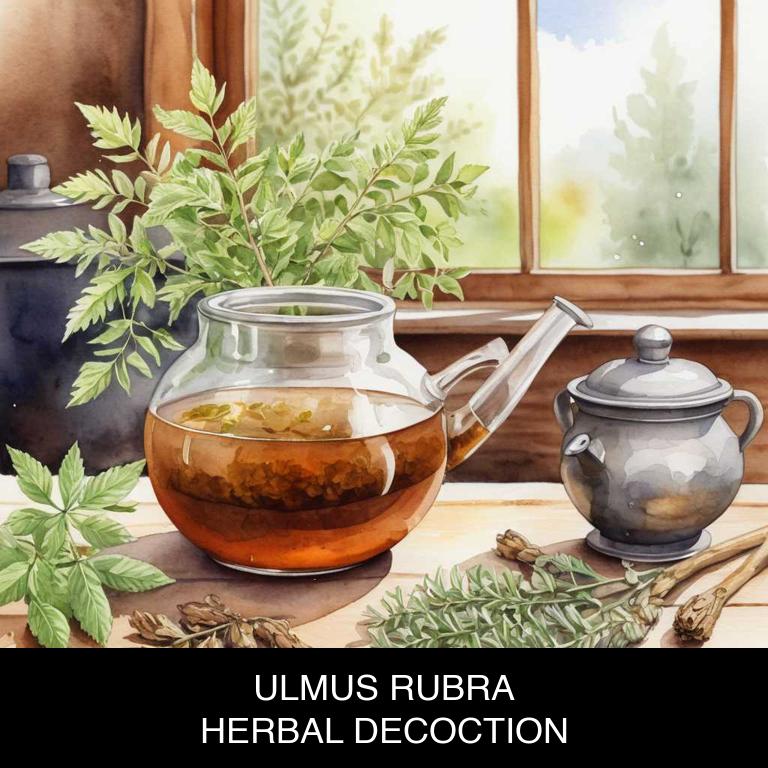
Medicinal Constituents
The list below shows the primary medicinal constituents in Ulmus rubra decoctions that help with fever.
- Flavonoids: They help with fever by exhibiting anti-inflammatory properties, which can help reduce the body's temperature and alleviate fever symptoms.
- Phenolic acids: They contribute to fever relief by demonstrating antimicrobial and anti-inflammatory activities, which can help combat infections and reduce fever.
- Tannins: They aid in fever management by exhibiting a cooling effect, reducing inflammation, and possessing antimicrobial properties, which can help alleviate symptoms associated with fever.
Parts Used
The list below shows the primary parts of slippery elm used to make decoctions for fever.
- Barks: Used for its astringent and anti-inflammatory properties to reduce fever.
- Roots: Used for its antipyretic and analgesic properties to help alleviate fever and pain.
- Leaves: Used for its diaphoretic and cooling properties to induce sweating and reduce fever.
Quick Recipe
The following recipe gives a procedure to make a basic slippery elm for fever.
- Gather 30 grams of dried ulmus rubra roots and 15 grams of dried ulmus rubra bark.
- Boil 2 liters of water for 5 minutes in a stainless steel pot.
- Combine the gathered ulmus rubra roots and bark into the boiling water.
- Reduce heat and simmer the mixture for 20 minutes then strain the liquid.
- Allow the decoction to cool completely before refrigerating it for later use.
9. Calendula officinalis
Pot marigold decoctions helps with fever because of its natural anti-inflammatory and antipyretic properties.
The flavonoids and terpenes present in pot marigold have been shown to reduce inflammation and alleviate symptoms associated with fever, such as headaches and body aches.
Additionally, the decoction's cooling effect on the skin can help bring down high temperatures, making it an effective natural remedy for relieving feverish sensations without disrupting normal body function.

Medicinal Constituents
The list below shows the primary medicinal constituents in Calendula officinalis decoctions that help with fever.
- Triterpenoids: These compounds possess anti-inflammatory properties, which can help reduce the body's temperature and alleviate symptoms associated with fever.
- Flavonoids: These polyphenolic compounds have potent antioxidant and anti-inflammatory effects, which can help mitigate the underlying causes of fever and promote a faster recovery.
- Carotenoids: These antioxidants can help reduce oxidative stress and inflammation, thereby supporting the body's natural response to fever and promoting a return to normal body temperature.
Parts Used
The list below shows the primary parts of pot marigold used to make decoctions for fever.
- Flowers: They are used due to their anti-inflammatory and antimicrobial properties, which help reduce fever and alleviate symptoms.
- Leaves: They are used due to their ability to stimulate sweating, which helps to cool the body and reduce fever.
- Roots: They are used due to their antiseptic and anti-inflammatory properties, which help to combat infections and reduce fever.
Quick Recipe
The following recipe gives a procedure to make a basic pot marigold for fever.
- Harvest 20-30 calendula officinalis flowers on a sunny day when they are fully bloomed and dry them completely.
- Combine 2 tablespoons of dried calendula flowers with 1 quart of boiling water in a heat-resistant container.
- Simmer the mixture for 5-7 minutes to release the active compounds from the flowers into the water.
- Strain the decoction through a cheesecloth or a fine-mesh sieve into a clean container to remove solids.
- Store the calendula decoction in a cool dark place for up to 2 days before using it as needed.
10. Curcuma longa
Turmeric decoctions helps with fever because of its unique compound curcumin, which has potent anti-inflammatory and antioxidant properties.
When taken as a decoction, curcumin is absorbed into the bloodstream, where it can target the source of the fever - whether it's a viral or bacterial infection - and help reduce inflammation.
By reducing inflammation, turmeric decoctions can help bring down body temperature and alleviate symptoms associated with fever, such as headache, fatigue, and body aches.
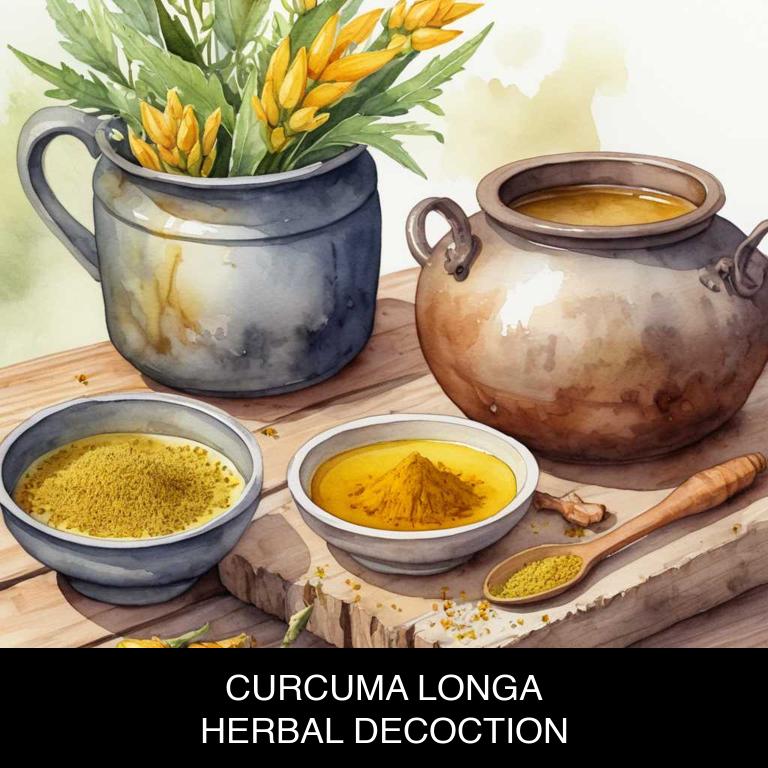
Medicinal Constituents
The list below shows the primary medicinal constituents in Curcuma longa decoctions that help with fever.
- Curcumin: It helps with fever by inhibiting the production of pro-inflammatory enzymes, such as cyclooxygenase-2 (COX-2), which contribute to the development of fever.
- Demethoxycurcumin: It helps with fever by exhibiting anti-inflammatory and antioxidant properties, which help reduce the severity of fever and alleviate associated symptoms.
- Beta-caryophyllene: It helps with fever by acting as a potent anti-inflammatory agent that reduces the production of pro-inflammatory cytokines, thereby alleviating fever and associated symptoms.
Parts Used
The list below shows the primary parts of turmeric used to make decoctions for fever.
- Rhyzomes: These are the most used parts of Curcuma longa for decoctions, as they contain high concentrations of curcumin, a key compound with anti-inflammatory and antimicrobial properties.
- Roots: The roots are also commonly used due to their ability to act as a natural antipyretic, helping to reduce fever in the body.
- Leaves: The leaves are another part used in decoctions, as they contain volatile oils that can help to relieve fever and other symptoms associated with it.
Quick Recipe
The following recipe gives a procedure to make a basic turmeric for fever.
- Harvest 3-5 fresh turmeric rhizomes about 2-3 inches long for decoction preparation.
- Wash the harvested rhizomes under running water and scrub them gently with a brush.
- Chop the rhizomes into small pieces and add them to 2 liters of water.
- Boil the mixture for 30-40 minutes over low heat or until the liquid reduces by half.
- Strain the decoction through a cheesecloth or a fine mesh into a clean container.
What is the best combination of herbal decoctions to use for fever?
The best combination of herbal decoctions that help with fever is a blend of Echinacea, Peppermint, and Ginger.
Echinacea is known for its immune-boosting properties, while Peppermint helps to reduce fever and alleviate headaches. Ginger, rich in anti-inflammatory compounds, adds to the decoction's ability to soothe and calm the body.
This harmonious blend can be consumed hot or cold, and is often paired with lemon and honey for added flavor and health benefits, promoting a swift recovery from fever.
What ailments similar to fever are treated with herbal decoctions?
Ailments similar to fever/decoctions.html">fever/decoctions.html">fever that are treated with herbal decoctions are rheumatic pain, arthritic inflammation, and skin infections.
Herbs such as turmeric, ginger, and willow bark are used in decoctions to reduce joint pain and inflammation, while herbs like neem, tea tree, and calendula help soothe skin irritations and infections.
These decoctions can provide effective relief without the side effects of pharmaceutical medications.